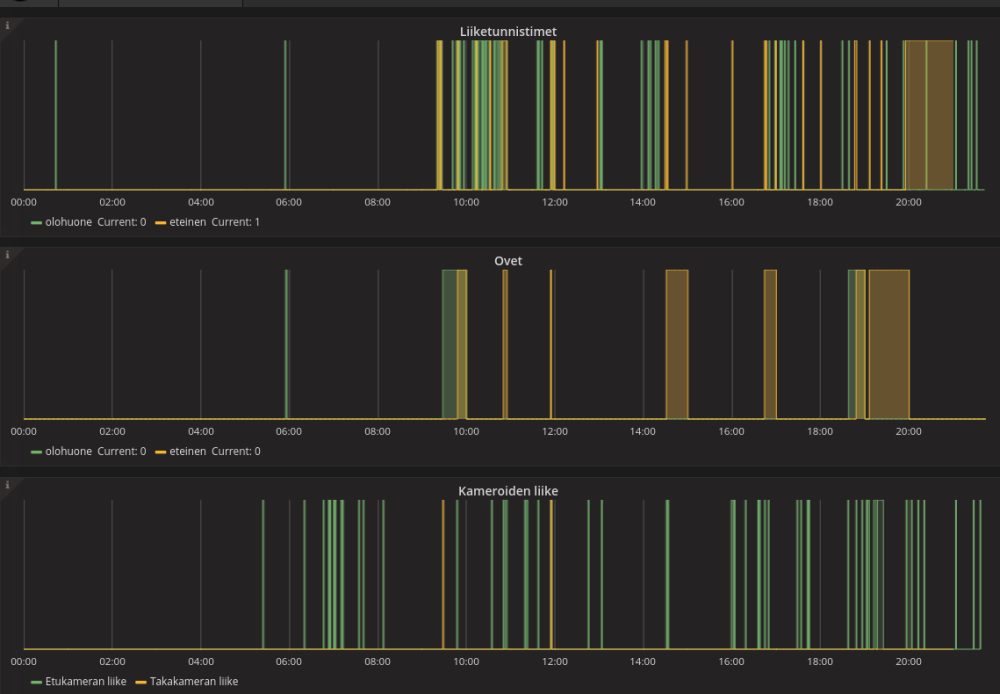3dprint case for motion, temp and humidity sensors with radio and batteries
-
My solution was to use a low drop out voltage high ripple rejection ratio voltage regulator 3V0 to power the PIR. That special voltage regulator is fed from the booster 3V3, that keeps the voltage to the PIR rock solid. The booster is noisy especially when the arduino goes from sleep to wake and back.
-
@therik I saw your old post about that. But the regulator you used has a 35uA quiescent current which is not "low" for a battery powered sensor ;)
With similar waste in your booster you are probably reaching a point where you would have similar battery life with 2 CR2450 and a simple xc6206 3.3V regulator, without a booster. -
Just to give an update anyone building similar setup. I managed to find a day to fix the systems. I thought the step-up booster is causing noise, so I added a capasitor to step-up output. It stabilised it enough so PIR doesn't give false alarms any more. Pheeeew... Finally working properly.

-
@ikket using a step up is not a good idea when using a PIR as it's very sensible to noise. A better solution is to add one more battery so even when they are nearly empty (1V) you've still got enough voltage to run your PIR.
-
@nca78 You can't really add one more battery, or you fry the radio which can handle only 3 and some Volts, right? If doing so, one needs to add step down regulator, so again loosing voltage. Or am I wrong?
@ikket said in 3dprint case for motion, temp and humidity sensors with radio and batteries:
@nca78 You can't really add one more battery, or you fry the radio which can handle only 3 and some Volts, right? If doing so, one needs to add step down regulator, so again loosing voltage. Or am I wrong?
You are not wrong, but XC6206 has a very low quiescent current (around 1uA) so you're losing voltage but not current and you can enjoy the full capacity of the CR2450/CR2477 batteries.
-
@ikkeT : would you mind sharing full details of your sketch and hardware setup (diagrams, ..) ?
That would be great since you already share the 3D case print.
Thanks,
ricorico94 -
Hi home automators,
I thought I share back my case here from thingiverse for those who do want to monitor home with sensebenders and alike. I draw and 3d printed this case for my sensebender and motion + door trap sensors. One of them is running with arduino pro mini, as I didn't have sensebender for that. It's a bit tight for that, but does it's job. Feel free to modify it, and please notify me if you enhance it, so I'll get the enhancements as well :)
http://www.thingiverse.com/thing:2144946

The angle on the motion sensor allows me to point the PIR range to certain parts where I want it, by placing the case in different ways. Turn to left, right or put it above the door to aim all over.
It's not state of art, but my first 3d drawing and my first arduino job. Code is pretty much copy paste from here. The device sleeps until sleep timer hits, or motion or door trap interrupts the sleep. To get the interrupt for both, you need to leave arduino pin 2 unused from the NRF24L01+ radio, as that reserves the edge interrupt pin from sensebender. There are only 2 edge interrupt pins on those arduinos.
The code is here for the devices, like said mostly copy paste (fork): https://github.com/ikke-t/sensebender
Mysensors GW on raspi forwards the traffic as MQTT forward to my node-red. That then sends gtalk messages of events if alarm is on. I recently also added openhab to listen to MQTT bus just out of curiosity.
@ikket greate Design
i have made some check out my designs
https://www.thingiverse.com/albaniac/designs -
I am about to put some door sensors up around my place. I love this idea of battery powered motion+door sensor. Just wondering if anyone has looked at something like the 18650's? The reason I ask is I have literally HUNDREDS of them from another on going project. Tons that aren't big enough for what I am working on but for uses like this it could work.
-
I am about to put some door sensors up around my place. I love this idea of battery powered motion+door sensor. Just wondering if anyone has looked at something like the 18650's? The reason I ask is I have literally HUNDREDS of them from another on going project. Tons that aren't big enough for what I am working on but for uses like this it could work.
@crankycoder there are very cheap holders for those on AliExpress/eBay etc
Then you just need a 3.3V regulator (I suggest XC6206 it's perfect for that) and an undervoltage protection if your batteries are not protected.The only problem is size, it's pretty hard to make a compact sensor with those :)
-
@ikkeT what cap did you put on the nrf?
because i also did have problems with transmission and i solved it with other caps in parrallel on vcc and gnd!
when on batteries:
10uf elektrolitic
0.1nf ceramic
100uf tantalumon the voltage regulator i think also before 0.1nf and a 10uf to lower the noise on the power line output
what you think about that?
grtz
